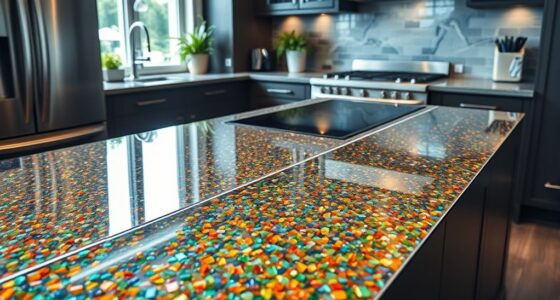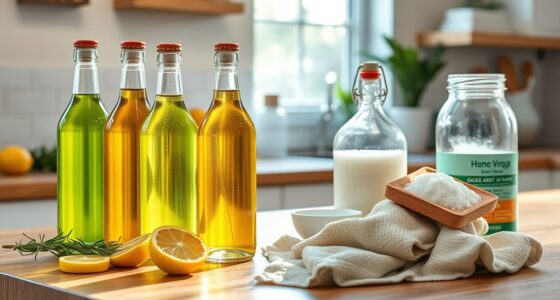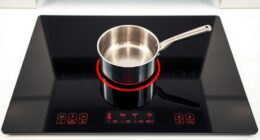Discover seven eco-friendly materials that can transform your home, including innovative options like mycelium, a biodegradable fungal structure perfect for insulation and furnishings. Ferrock offers a carbon-negative, super-strong alternative to concrete, while hempcrete provides excellent insulation and moisture control. Recycled plastic, Enviroboard, AshCrete, and cork each bring durability, sustainability, and unique benefits for walls, floors, and surfaces. Keep exploring to see how these materials can help you build greener, stronger, and smarter spaces.
Key Takeaways
- Mycelium panels offer biodegradable insulation and furnishings with rapid growth for scalable, eco-friendly construction.
- Ferrock, a carbon-negative, ultra-strong concrete alternative, absorbs CO2 and enhances durability while reducing waste.
- Hempcrete provides superior thermal insulation and carbon-negative benefits, improving indoor air quality and moisture regulation.
- Cork walls and flooring deliver natural, fire-resistant insulation, noise reduction, and renewable harvesting without harming trees.
- Recycled plastic panels and Enviroboard promote circular economy principles, resisting weather and pests, and reducing landfill waste.
Mycelium: The Fungal Wonder for Eco-Friendly Building
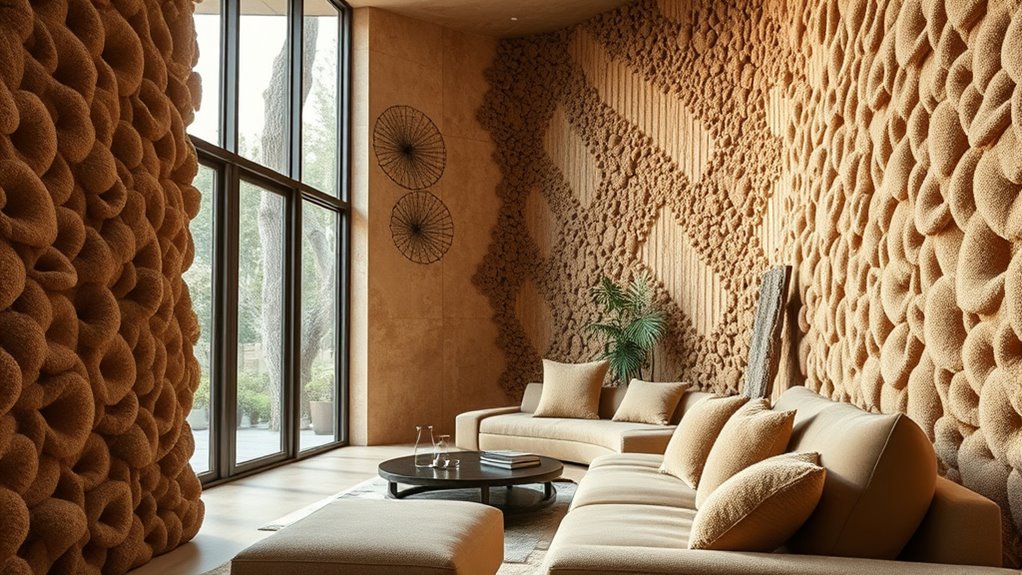
Have you ever considered how fungi could revolutionize eco-friendly construction? Mycelium, the root-like structure of fungi, offers a sustainable building material that’s both biodegradable and eco-conscious. You can cultivate mycelium into lightweight, strong panels perfect for insulation, flooring, or furnishings. Its natural resistance to mold, water, and fire makes it a practical choice for eco-friendly homes. Compared to plastics and foams, mycelium-based materials can match, or even surpass, traditional concrete in durability. Additionally, the rapid growth cycle—taking just a few weeks—enables scalable, cost-effective production. This rapid development process allows for quick deployment in building projects, reducing construction time and costs. When its life cycle ends, the material can be composted, drastically reducing waste. Supporting sustainable building practices by adopting mycelium means you’re fostering a biodegradable and environmentally friendly approach. Embracing mycelium means you’re supporting a sustainable building approach that’s biodegradable and environmentally friendly. Understanding the environmental impact of traditional construction materials highlights the importance of adopting innovative, eco-conscious alternatives like mycelium. Incorporating biodegradable materials into construction can significantly lessen our ecological footprint and promote greener living environments.
Ferrock: The Carbon-Negative Concrete Alternative
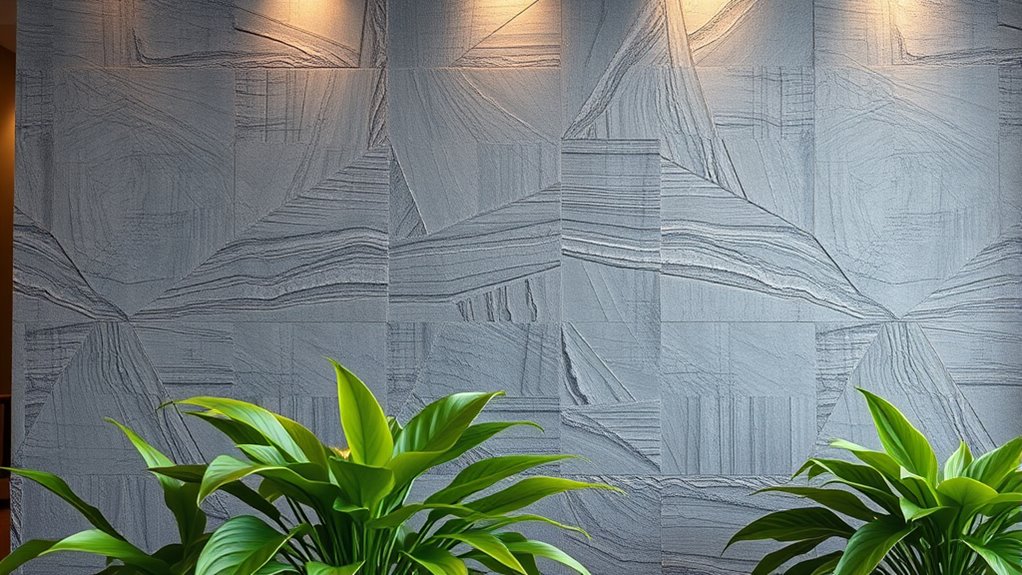
Ferrock is a groundbreaking, eco-friendly concrete alternative that’s made from recycled industrial waste. It absorbs CO2 during curing, making it a carbon-negative material, and is five times stronger than traditional concrete, ensuring lasting durability. Its lightweight and dense structure make it ideal for demanding applications like marine environments, all while promoting waste reuse. Additionally, Ferrock’s significant strength makes it a sustainable choice for construction projects seeking durability and environmental benefits. Its color consistency ensures a uniform appearance, further enhancing its suitability for various architectural applications. Moreover, the material’s environmental impact is minimal, making it an increasingly popular choice among eco-conscious builders and developers. Its ability to utilize waste materials effectively contributes to a sustainable construction movement that reduces reliance on traditional resources. Using innovative building materials like Ferrock can help reduce the carbon footprint of construction projects and promote eco-friendly development.
Eco-Friendly Composition
Did you know there’s a concrete alternative that not only reduces environmental impact but actively absorbs CO2 during its curing process? Ferrock’s eco-friendly composition is built from 97% recycled materials, including steel dust and ground glass, making it an excellent choice for sustainable building. Its innovative design repurposes waste that would otherwise end up in landfills, lowering greenhouse gas emissions. The use of recycled components results in a material with smaller pores than traditional concrete, which enhances resistance to water, cracking, and environmental damage. Additionally, Ferrock’s carbon-negative properties enable it to absorb more CO2 than is emitted during production, further reducing its environmental footprint. The recycling process involved in manufacturing Ferrock helps close material loops and reduces reliance on virgin resources. This eco-friendly material not only minimizes environmental harm but also contributes to creating healthier, more sustainable homes. By choosing Ferrock, you’re supporting a greener construction approach that promotes waste repurposing. Its unique composition also benefits from noise reduction technology, which helps create quieter building environments. Moreover, ongoing research into sustainable construction materials continues to drive innovation in eco-conscious building solutions. Its unique composition not only minimizes environmental harm but also contributes to creating healthier, more sustainable homes. This eco-friendly material truly transforms the way we build.
Superior Strength and Durability
Thanks to its innovative design, Ferrock offers unmatched strength and durability compared to traditional concrete. Its high durability guarantees your structures maintain their integrity over time, resisting cracking, water infiltration, and fire. Made from recycled steel dust and ground glass, Ferrock is a sustainable choice that reduces environmental impact. Its smaller pore structure enhances resistance to damage, extending the lifespan of your projects. Plus, Ferrock absorbs CO2 during curing, making it carbon-negative. With five times the strength of Portland cement, it guarantees superior structural integrity for demanding applications. Here’s a quick comparison: natural materials contribute to its authenticity and eco-friendliness, aligning with sustainable building practices.
| Material | Durability | Structural Integrity |
|---|---|---|
| Traditional Concrete | Moderate | Good |
| Ferrock | Excellent | Superior |
| Steel | Very High | Very High |
Hempcrete: The Sustainable Insulating Marvel

Hempcrete has emerged as a remarkable sustainable building material, combining eco-friendliness with excellent insulating properties. This lightweight, breathable composite made from hemp fibers, lime, and water provides superior thermal insulation, helping you cut energy costs. Its R-values rival traditional insulation, making it a smart choice for eco-friendly building. Hempcrete is also carbon-negative because hemp absorbs more CO2 during growth than is emitted during manufacturing, further reducing your environmental footprint. In addition, hempcrete’s reusable options available support eco-conscious choices by minimizing waste and promoting sustainable resource use. Moreover, hempcrete’s moisture regulation helps prevent mold and maintain indoor air quality, contributing to healthier living environments. The material’s biodegradable nature ensures that it decomposes naturally at the end of its lifespan, reducing landfill waste. Plus, it’s fire-resistant, pest-resistant, and mold-resistant, promoting healthier indoor air quality. You can easily apply hempcrete around existing structures or incorporate it into new builds, supporting sustainable construction practices. Choosing hempcrete not only enhances your home’s insulation but also contributes positively to the planet’s health, emphasizing the importance of sound design principles like effective material integration in sustainable architecture.
Enviroboard: The Water-Resistant Fireproof Panel

Enviroboard stands out as an innovative, eco-friendly building panel designed to meet the demands of sustainable construction. Its unique composition of magnesium, sawdust, and fiber cloth makes it both water-resistant and fireproof, ensuring durability and safety. You’ll find it ideal for various applications like wall lining, roof lining, and underlay. Its key benefits include:
- Superior water resistance, preventing warping over time
- Enhanced fireproof properties for added safety
- Strength and longevity surpassing traditional gypsum or cement boards
Additionally, the natural drying and curing process of Enviroboard contributes to low carbon emissions, reinforcing its environmentally conscious profile. This versatile, eco-friendly panel transforms your building projects by combining durability with sustainability, ensuring your home remains safe and eco-conscious. Its sustainable manufacturing process further emphasizes its role in reducing environmental impact, supported by energy-efficient production methods that minimize resource use.
Recycled Plastic: Transforming Waste Into Durable Material
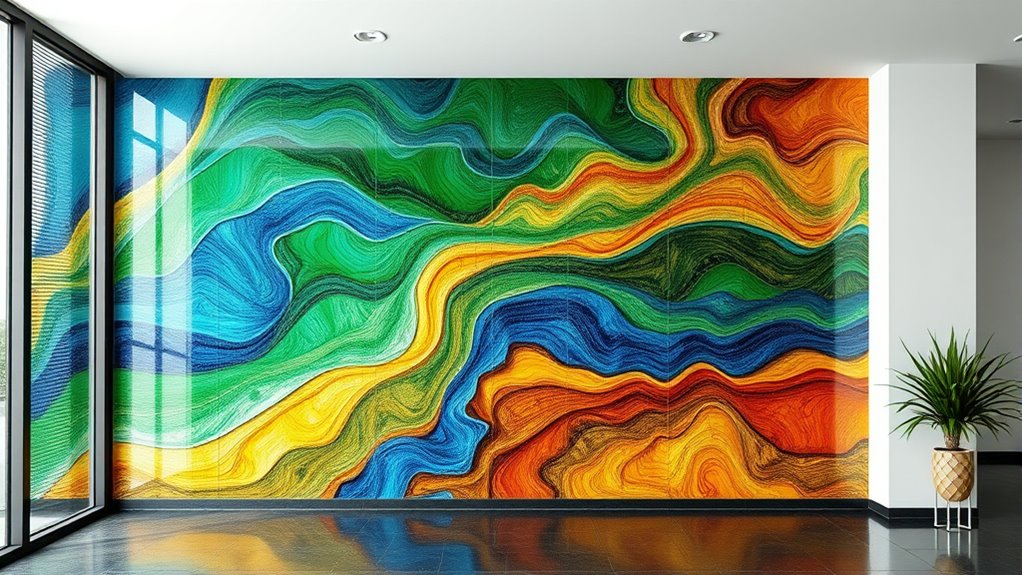
Recycled plastic helps cut down environmental waste by turning PET bottles and bags into durable materials, preventing them from taking centuries to decompose. It’s processed with eco-friendly methods that lower greenhouse gas emissions, making it a smarter choice for construction. With its strength and resistance, recycled plastic opens up versatile options like outdoor decks, fencing, and lightweight building components.
Environmental Impact Reduction
Transforming waste into durable materials, recycled plastic plays a vital role in reducing environmental impact. By repurposing plastic that can take over 450-1000 years to decompose, you help cut down landfill waste. Using recycled plastic in sustainable building practices offers significant benefits:
- It lowers carbon emissions during production through carbon-neutral, non-toxic processes.
- It reduces plastic waste polluting oceans, parks, and homes.
- It creates long-lasting outdoor materials resistant to weather, rot, and insects.
Incorporating recycled plastic into your home projects supports circular economy principles and reduces reliance on virgin materials. This approach not only helps protect ecosystems but also promotes eco-friendly construction, making your home more sustainable while minimizing your environmental footprint.
Versatile Construction Uses
By repurposing waste plastic into building components, you can create durable materials like decking, fencing, and structural panels that reduce reliance on traditional lumber. Recycled plastic serves as a versatile construction material, offering a sustainable alternative that withstands weather, rot, pests, and corrosion. Its durability makes it ideal for outdoor applications such as garden furniture and fencing, while its resistance to environmental damage extends its lifespan. Manufacturing recycled plastic involves carbon-neutral, non-toxic processes that considerably lower greenhouse gas emissions compared to concrete. Using these sustainable building materials not only diverts plastic waste from landfills and oceans but also promotes a circular economy. Incorporating recycled plastic into your projects enhances versatility in construction, making your home more eco-friendly and resilient.
AshCrete: The Fly Ash-Based Eco-Concrete

AshCrete offers a sustainable alternative to traditional concrete by utilizing mostly recycled materials like fly ash, borate, and bottom ash. This eco-friendly mix features smaller pores and greater strength, making it highly durable for construction projects. Using AshCrete provides several benefits:
- Reduces cement consumption, lowering carbon emissions
- Diverts industrial waste from landfills, promoting waste reuse
- Enhances energy efficiency through superior thermal insulation
Cork: The Resilient and Renewable Building Surface
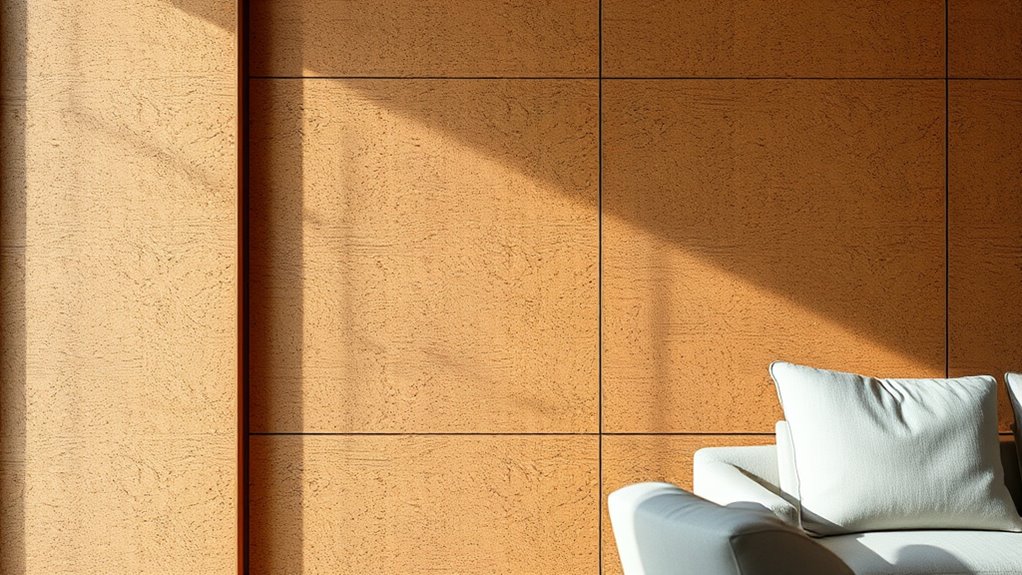
Cork emerges as a versatile and sustainable building surface that complements eco-friendly construction practices. Harvested from the bark of cork oak trees without harming them, cork is a renewable resource, allowing for sustainable harvesting every 9-12 years. Its cellular structure, made up of 50% air, makes cork an excellent natural insulator, helping you cut energy costs and reduce your carbon footprint. Cork is highly resistant to mold, mildew, moisture, and fire, ensuring durability and safety in various applications. Whether used for flooring, wall coverings, or acoustic panels, cork’s lightweight and resilient qualities make it easy to install and maintain. Plus, its ability to absorb vibrations and noise creates a quieter, more comfortable indoor environment — all while supporting eco-conscious building choices.
Frequently Asked Questions
What Is the Most Eco-Friendly Material to Build a House With?
You want to build an eco-friendly house, and choosing the right material makes a big difference. Hempcrete stands out because it’s made from fast-growing hemp that absorbs more CO2 than is emitted during production. It’s renewable, biodegradable, and provides excellent insulation. Combining hempcrete with reclaimed wood, sustainable cork, recycled steel, or mycelium creates a truly green, energy-efficient home that’s good for the environment and comfortable to live in.
What Is a Sustainable Material to Make a House Out Of?
Imagine building a house so eco-friendly, it practically breathes with nature! A fantastic sustainable choice is reclaimed wood—you reuse old timber, saving countless trees and reducing environmental harm. Pair it with hempcrete for insulation, recycled steel for strength, and cork for natural soundproofing. Together, these materials create a home that’s not only beautiful and durable but also a superhero in saving the planet while making your space cozy and stylish.
What Is the Most Eco-Friendly Thing?
When asked what the most eco-friendly thing is, it depends on your priorities. You might consider cork, which regenerates quickly and insulates well, or hemp, a fast-growing crop that absorbs lots of CO2. Reclaimed and recycled materials also make a big impact by reducing waste. Mycelium offers biodegradable building options, while natural locally sourced materials like cob or adobe cut transportation emissions. Ultimately, choosing sustainable options aligns with your eco-conscious values.
What Is More Eco-Friendly Than Concrete?
You might be surprised, but some materials are even kinder to our planet than traditional concrete. For instance, AshCrete, made from 97% recycled fly ash, offers greater strength and eco-friendliness. Ferrock absorbs CO2 during curing, reducing greenhouse gases. Rammed earth walls use natural, local materials with minimal impact. Recycled glass aggregates and mycelium-based composites also provide sustainable alternatives that help lower your home’s carbon footprint.
Conclusion
Imagine your home woven with the gentle strength of mycelium, the warm embrace of hempcrete, and the vibrant energy of recycled plastics. Each eco-friendly material transforms your space into a sanctuary where sustainability blooms and waste becomes wonder. As you embrace these innovations, picture a future where your walls breathe life, and your choices ripple outward, shaping a greener, brighter world—one sustainable building block at a time.



